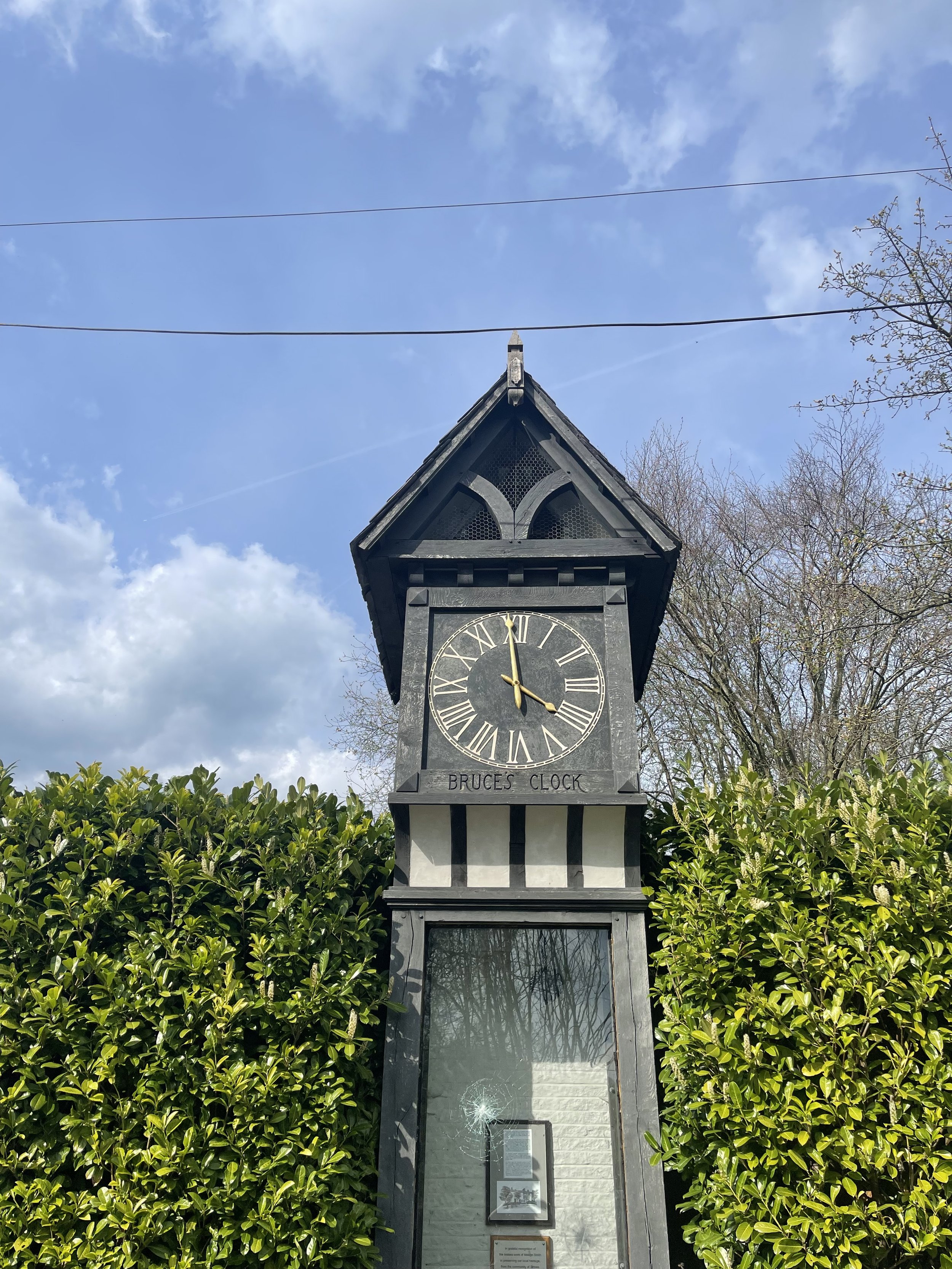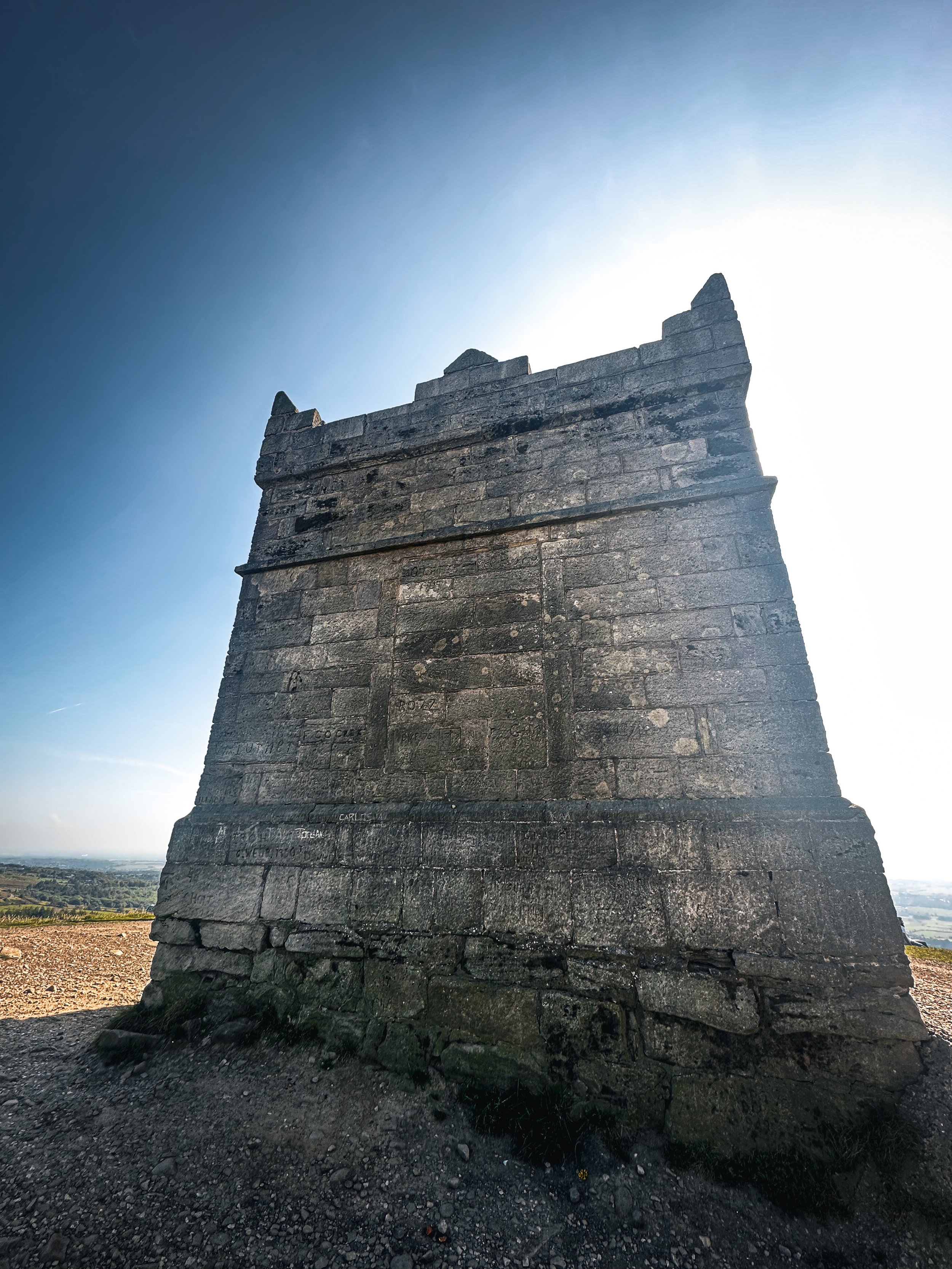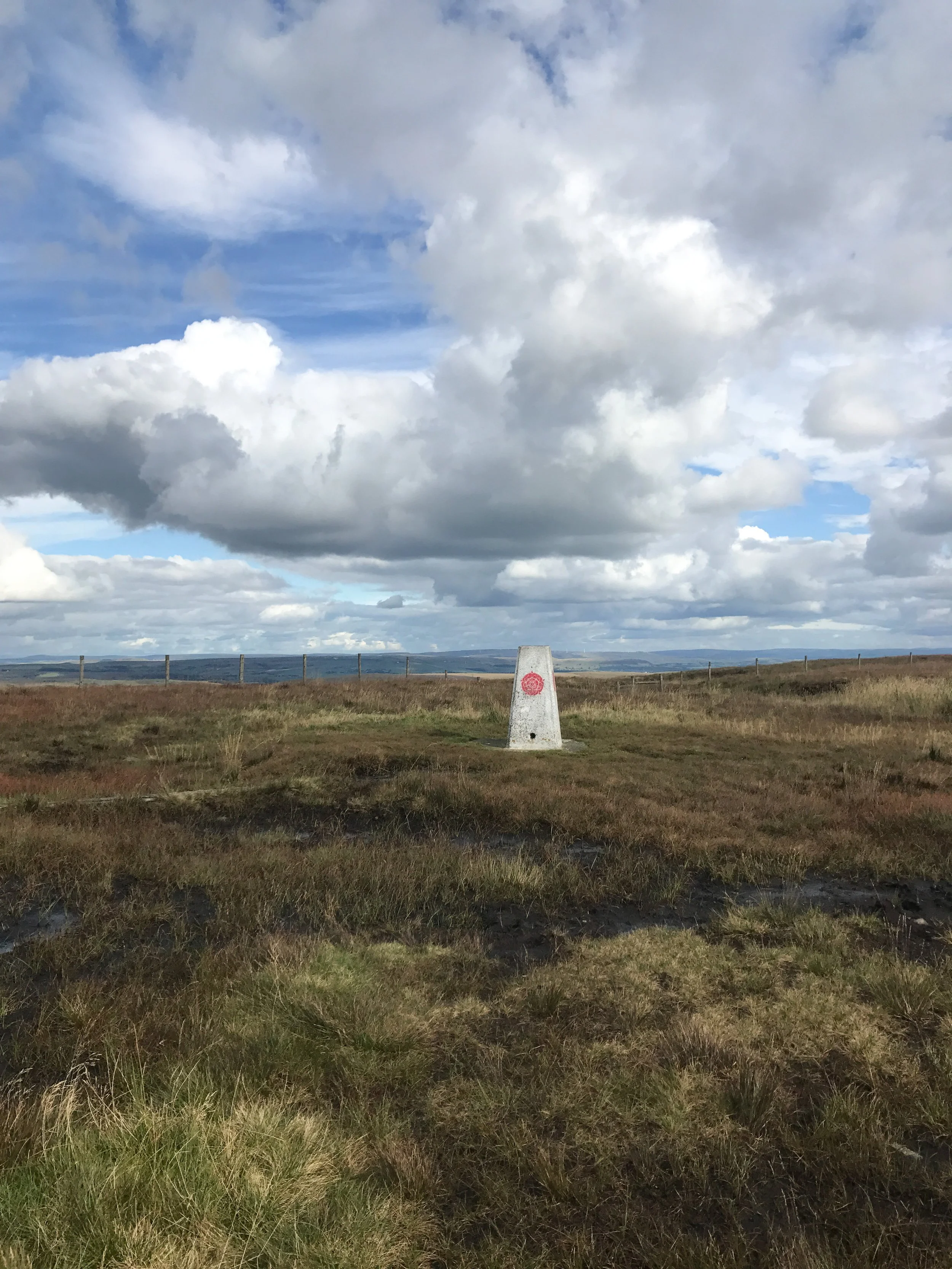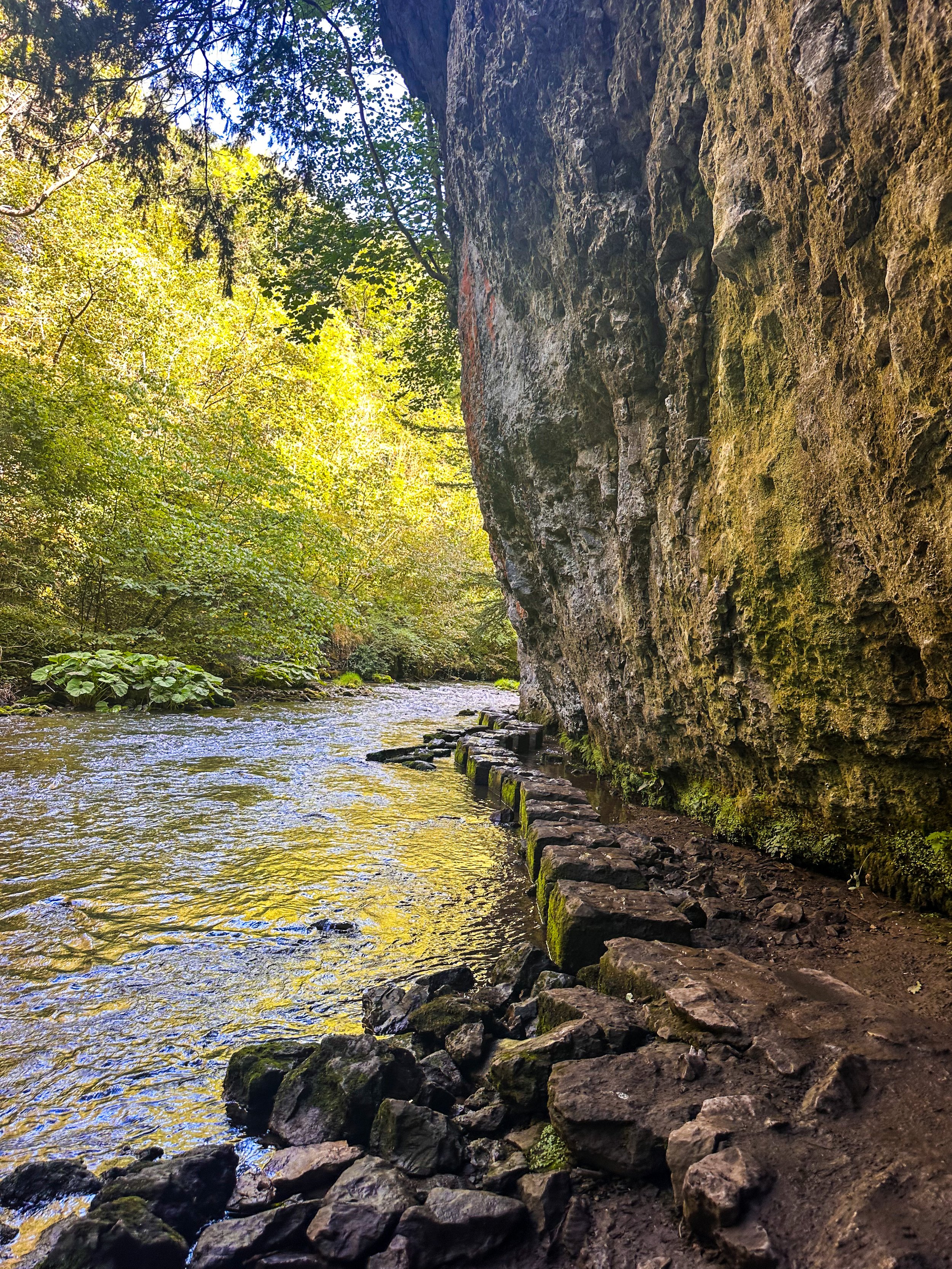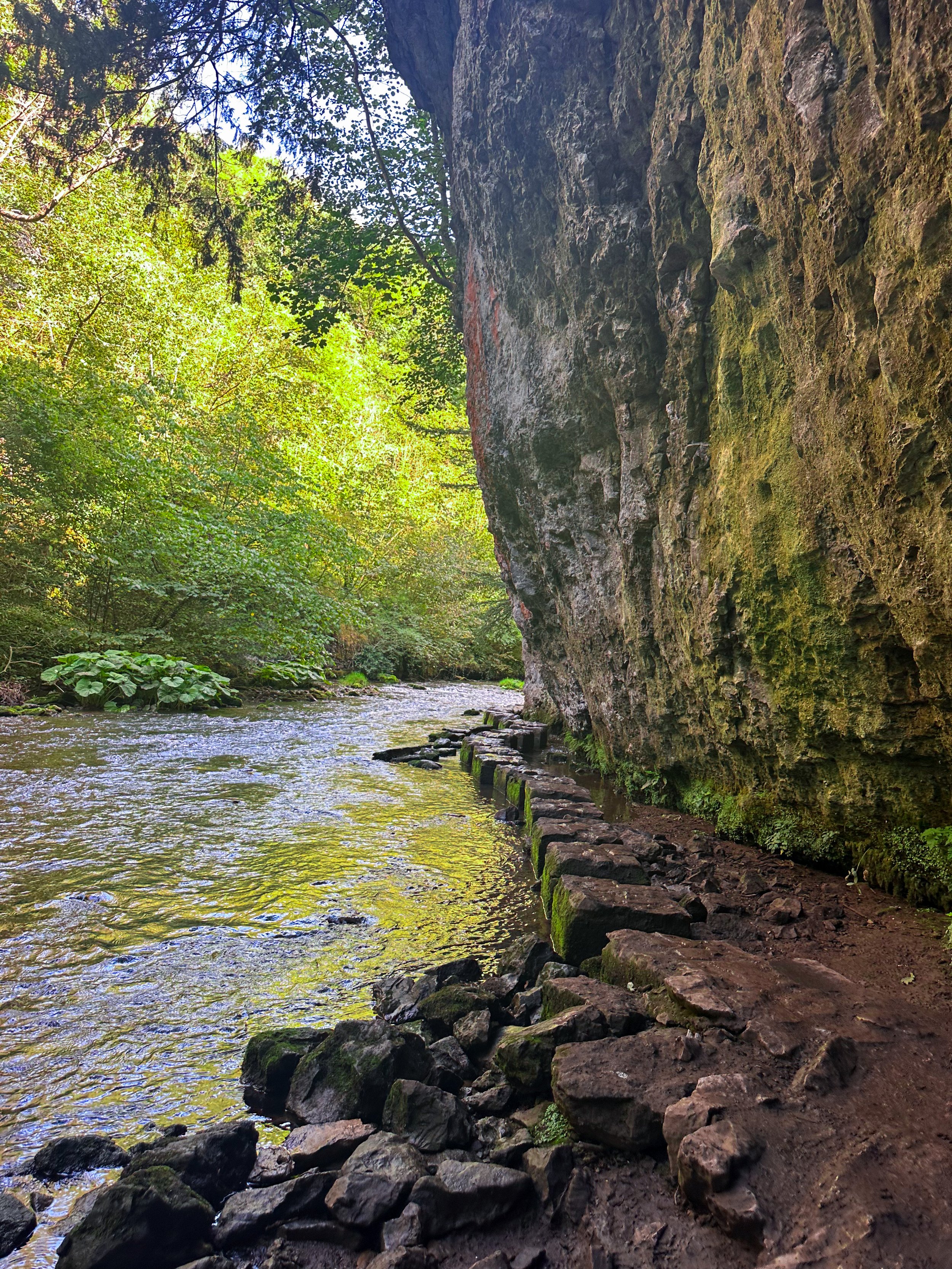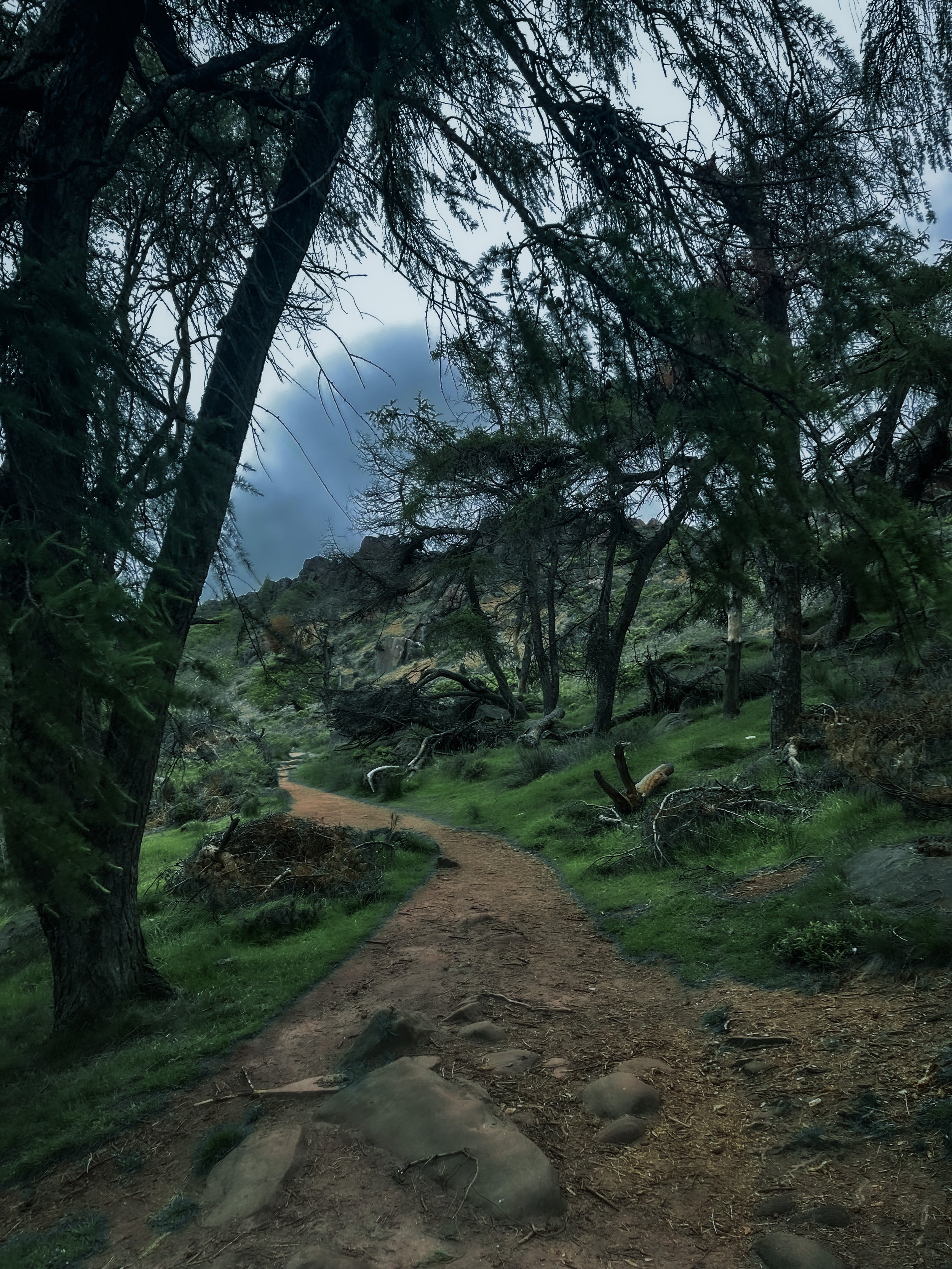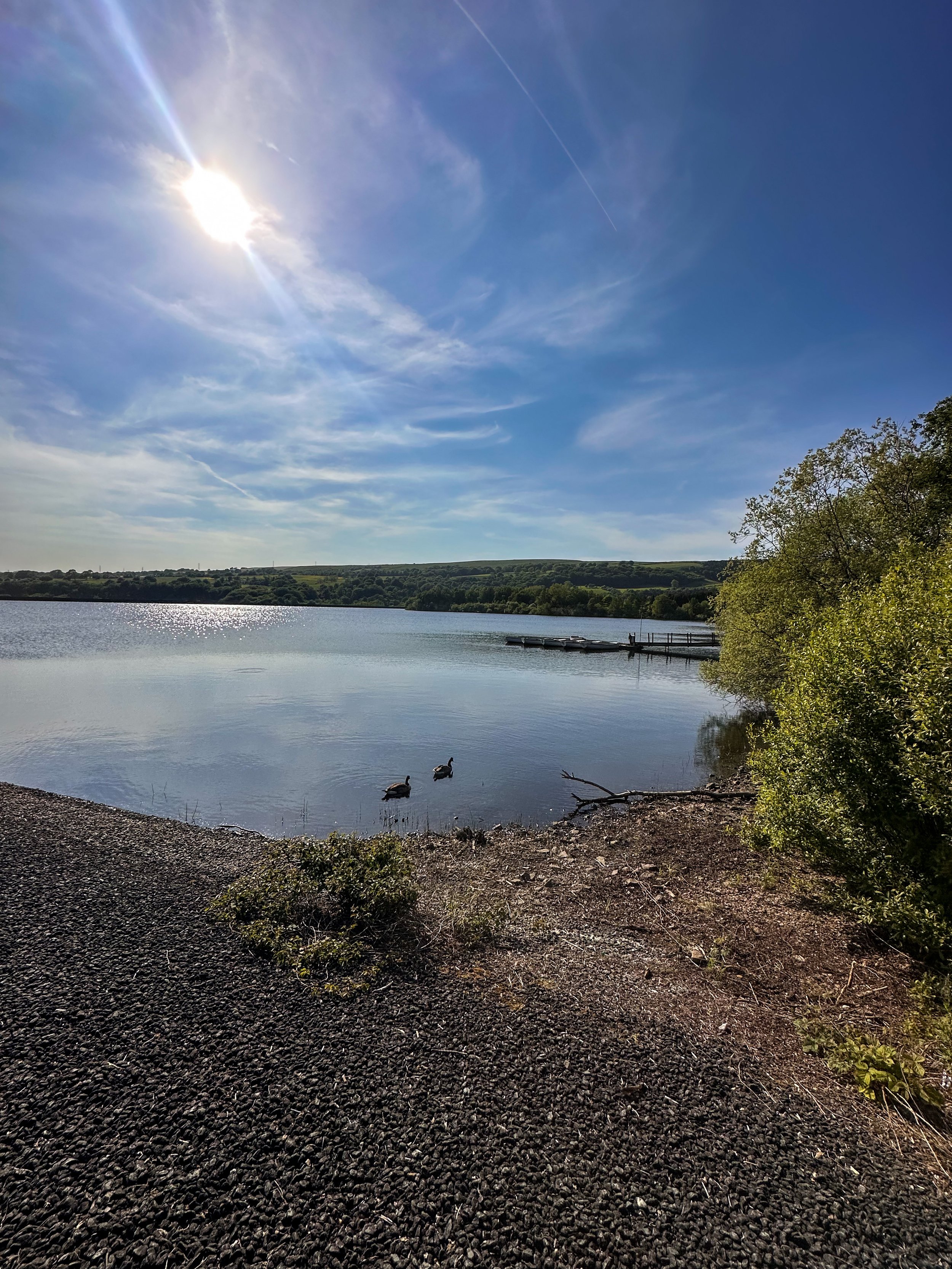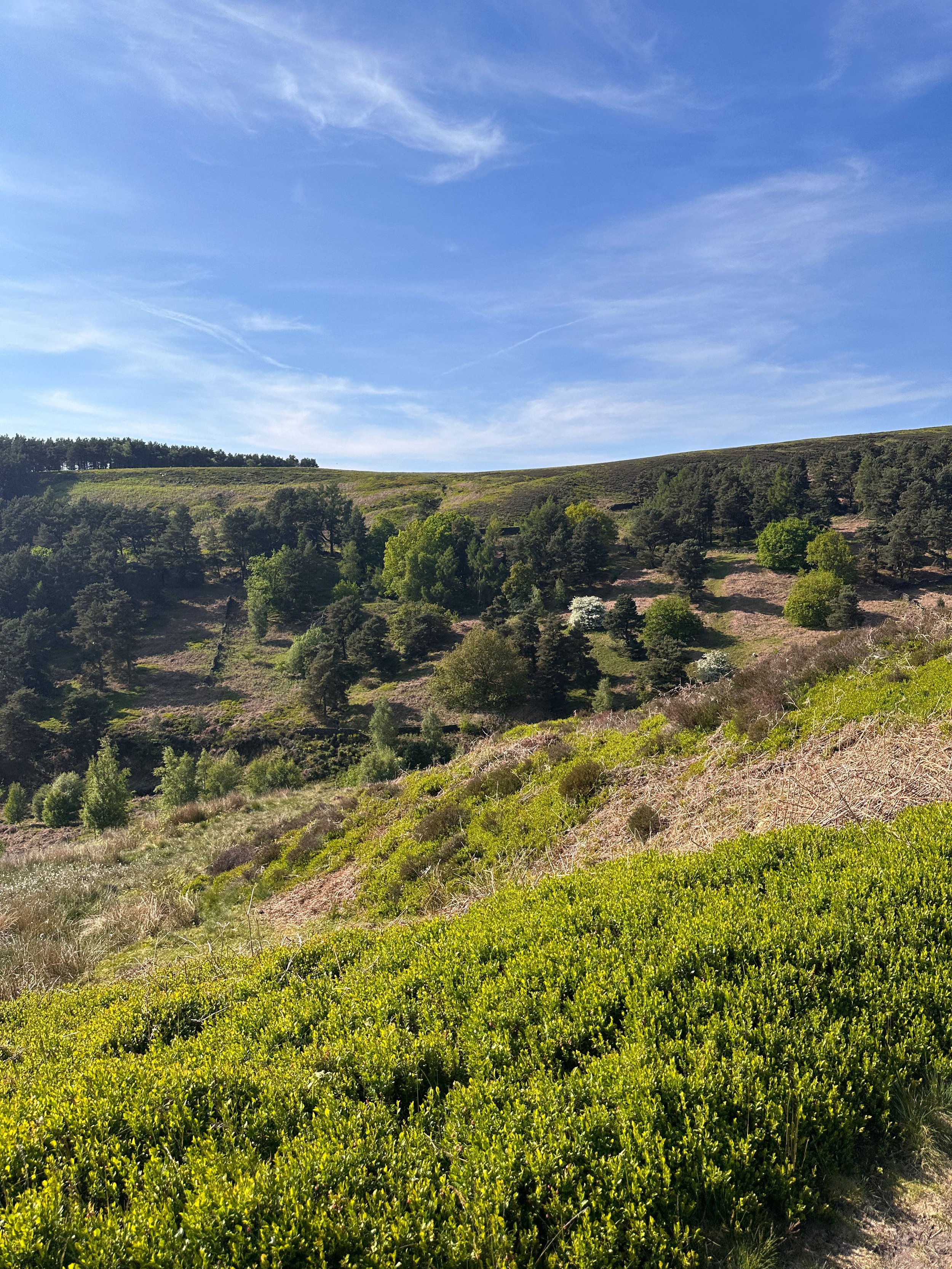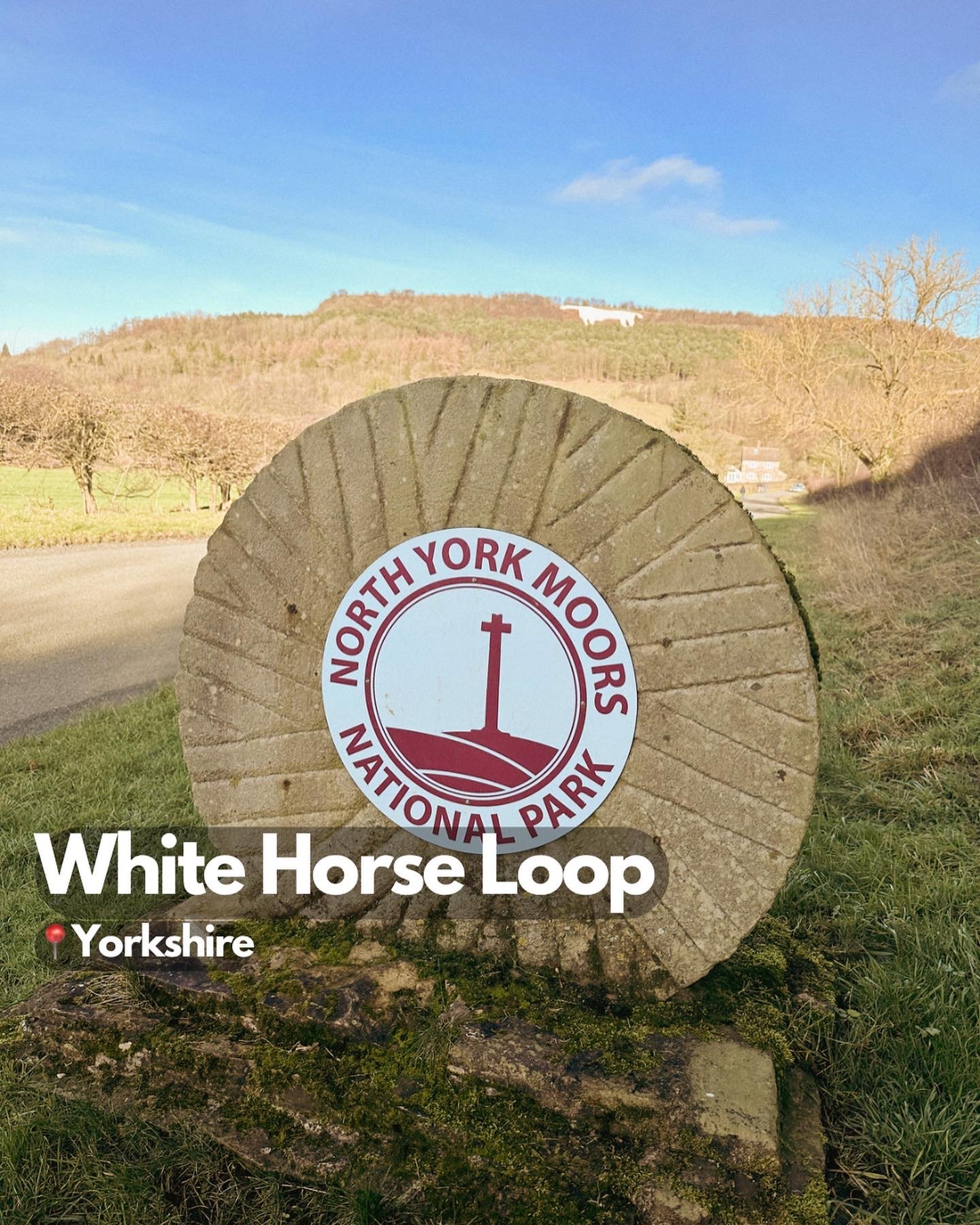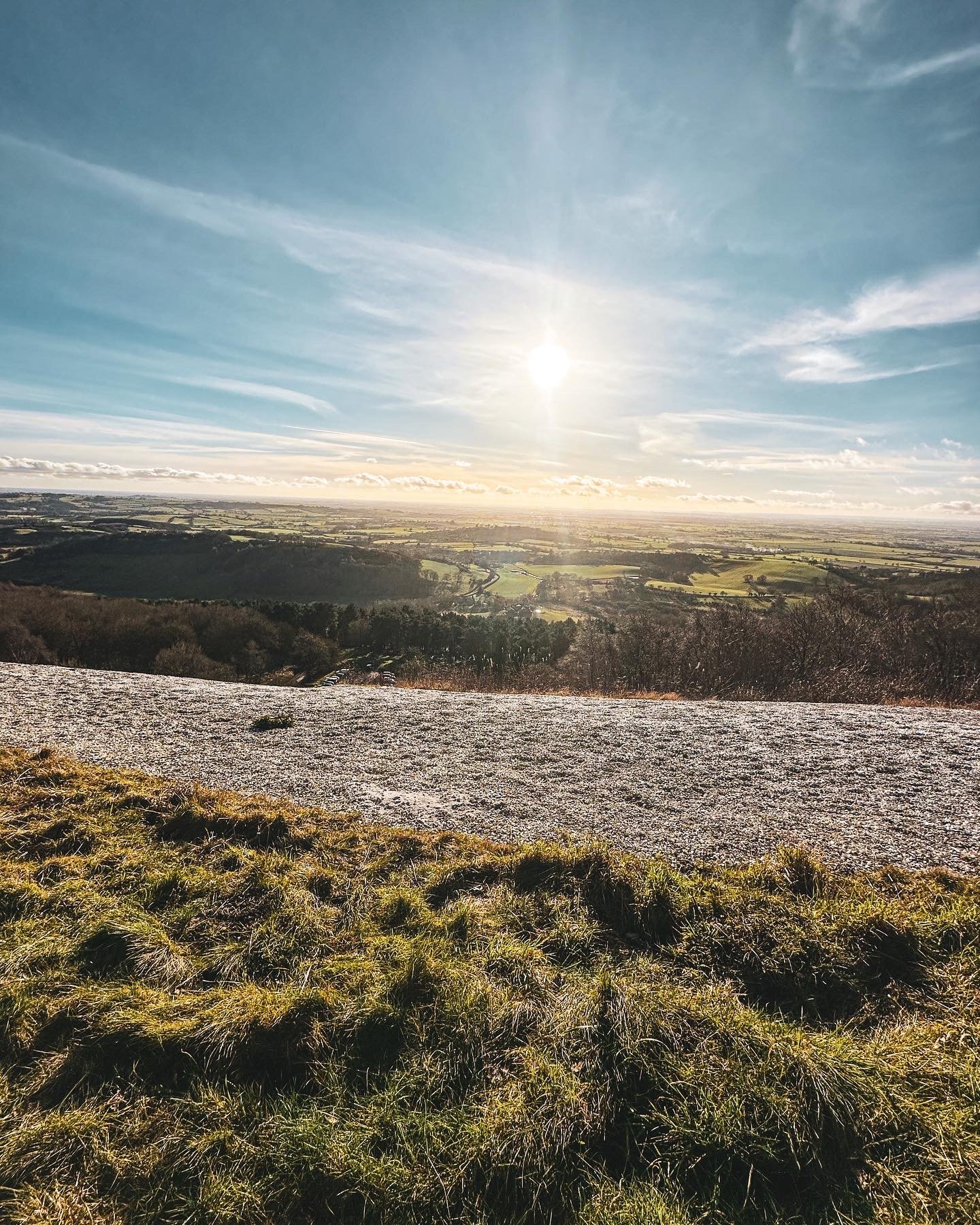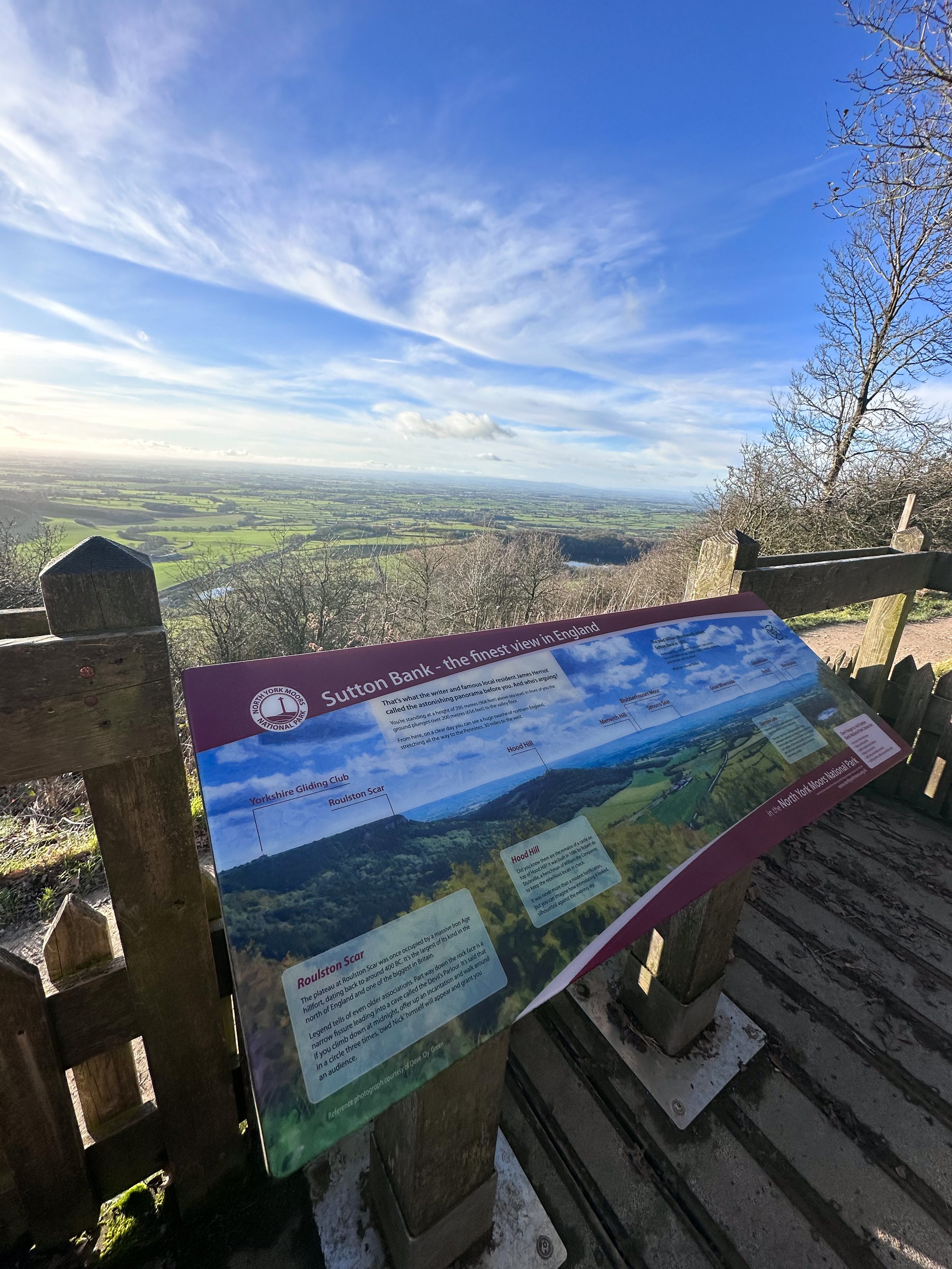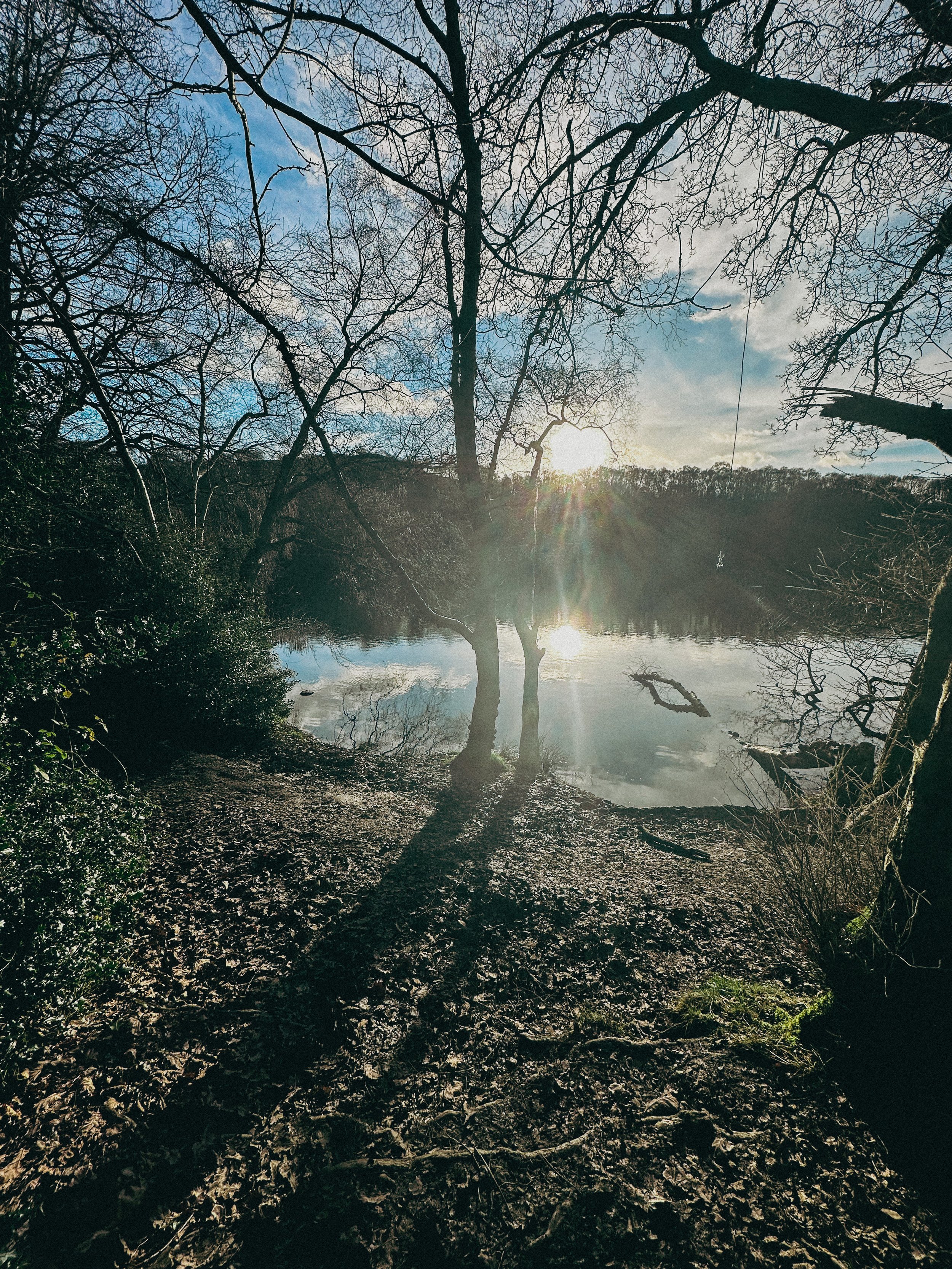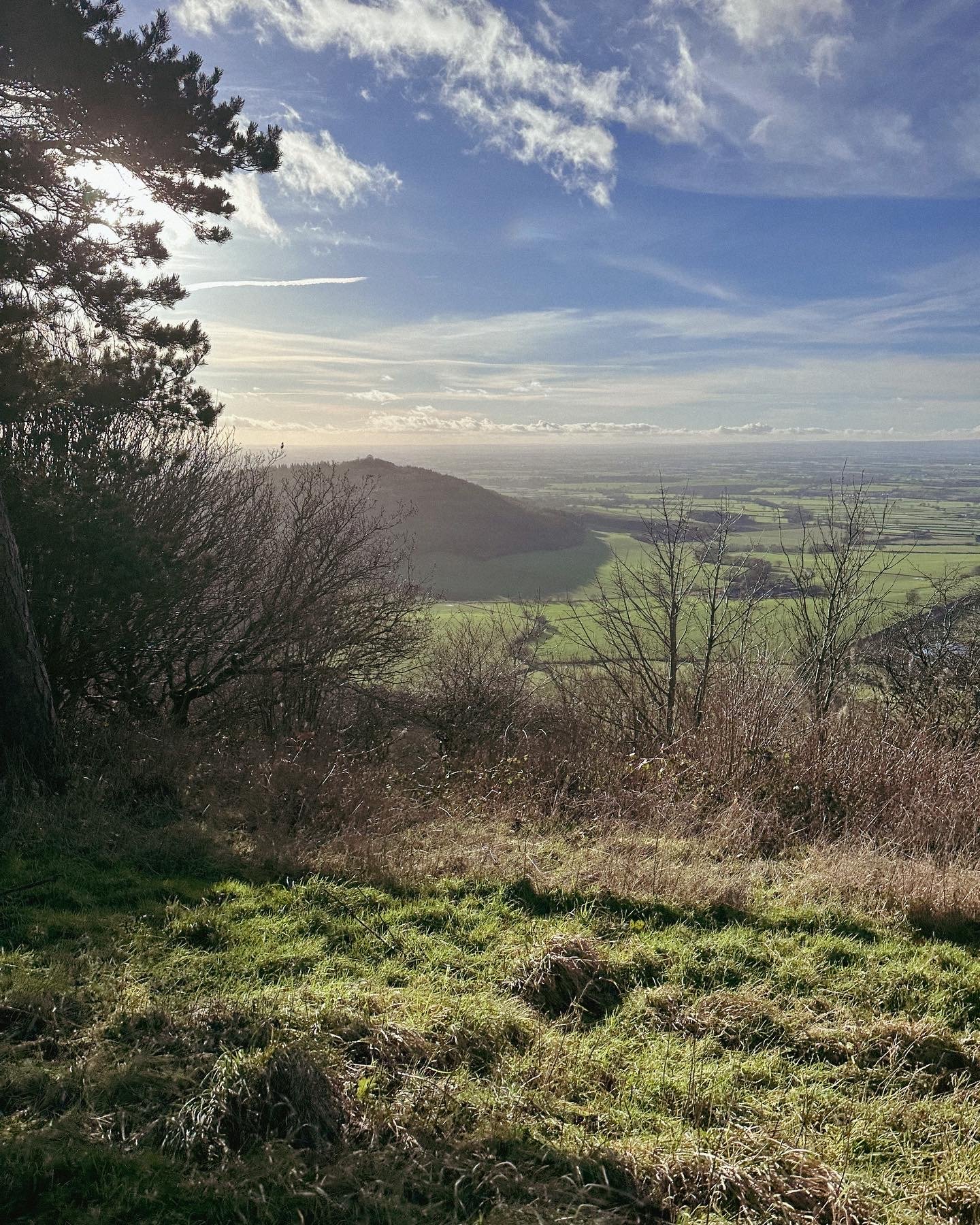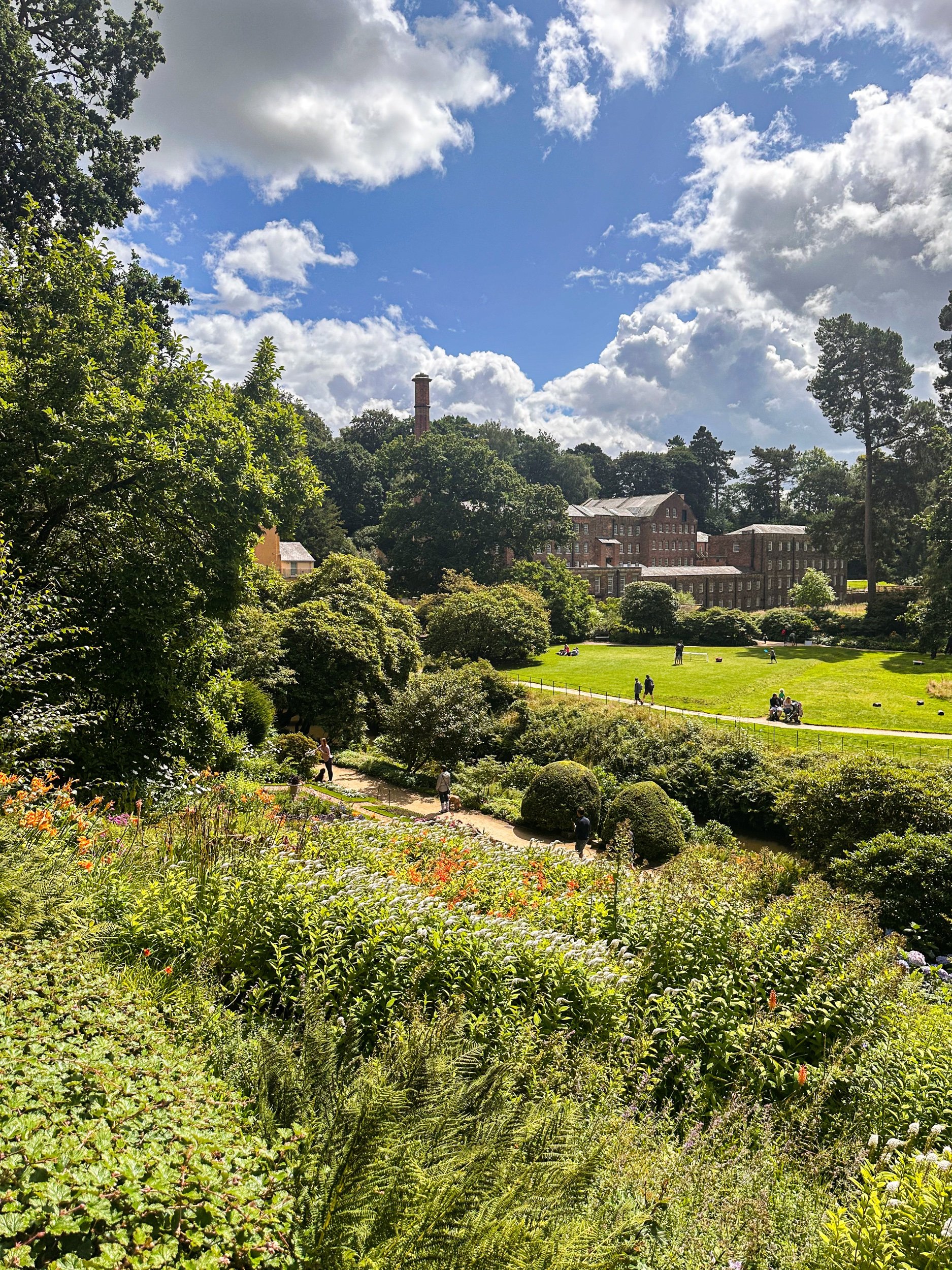ALL TRAILS
SOLOMON’S TEMPLE WALK
An short but idyllic in Buxton boasting impressive views
Perched high over the idyllic town of Buxton lies a monument like no other. Solomon’s Temple is Buxton’s very own folly. The Victorian viewpoint tower built in 1896 stands proudly atop the summit of Grin Low - and, unlike the true spirit of a folly (which usually have no practical purpose whatsoever), Solomon’s Temple actually occupies a site of ancient significance.
It’s built on the site of a tumulus, a Neolithic burial chamber, and replaced the ruins of an earlier structure built by Solomon Mycock. Before the existing tower was built, the area was excavated and contained several skeletons from the Beaker period - spooky stuff.
Grin Low, which Solomon’s Temple is built on, was the main location for the early Buxton lime industry. The large, oddly shaped mounds you see on the walk up to the summit are widespread remains of over 100 large ‘pudding’ lime kilns which date from the 17th-19th centuries.
And as for the route itself? Well, it’s one of our favourite walks this side of the Peaks, that’s for sure.
With your choice of woodland trails leading from Poole’s Cavern to the summit, you’re sure to be met with beautiful landscape and spectacular views whichever way you venture.
Fancy giving it a go? Follow the route here
NEW MILLS MILLENIUM WALKWAY WALK
Come with us on this short (but oh so scenic) walk just 20 minutes from Manchester…
On initial glance, New Mills may look like any ordinary Peak District village: small, picturesque with little much-to-do around the town. Venture just a few steps downwards towards the River Sett, and you enter another landscape entirely.
We’ve partnered with In Our Nature, Manchester’s biggest climate movement, to show you don’t always need to grab for the car keys to enjoy a wonderful day out in the Peaks.
Whether you want a lazy Sunday stroll or are seeking a fully day of exploring, New Mills is a great base for all types of adventures.
That’s why we’ve got two routes for you to choose from. The first, a short 4 mile loop that leaves plenty of time to explore the many wonderful independent shops and cafes in New Mills town centre. The second is a 10 mile loop which you can start from either New Mills or Marple, with easy train links from Manchester to both starting points.
Route #1: The Torrs Circular
Start: New Mills Central Station
Distance: 4 miles
Elevation: 300 feet
Difficulty: Easy
Duration: 1.5 hours
Navigation: Download the GPX file here
The Millenium Walkway and The Tours
Below the hustle and bustle of the main shopping centre lies New Mill’s (not so) hidden gem: The Torrs. We’ve done this walk a few times, and every time we’re amazed by the astounding natural gorge that lies below.
Expect colourful cliffs, enormous viaducts and a long bridge that transports you to the Goyt Way — making for one of the best lesser-known walks in Derbyshire.
Millers Refillers
The beauty of this shorter route means, not only can you take it at your own leisure, but you have the full day to explore the many wonderful shops, pubs and cafes that New Mills has to offer. Make sure you check out this iconic zero waste shop, stocking everything from baking essentials, flours sugars, pulses, rice, pasta, nuts, dried fruits, seeds, spices, oils, vinegars, sweet treats and snacks, and so much more.
Route #2: Mellor Cross
Distance: 10.5 miles
Duration: Allow approx. 4 hours
Elevation: 1,200 feet
Difficulty: Moderate
Navigation: Download the GPX file here
If you’re wanting to make a full day of it and check out some of Stockport’s forgotten while you’re at it, then this route’s for you. While The Torrs itself makes for a great short circular route if you’re not planning on venturing far, this longer walk is perfect for summer days spent exploring.
From Marple, you’ll head towards The Roman Lakes and passed the site of Mellor Mill Ruins. Once a shining star or the Oldknow Empire, Mellor Mill was the biggest spinning mill the world had seen during its time of construction. What remains of the mill have since been taken over by the natural world, making for a gorgeous pitstop by the Peak Forest Canal and River Goyt.
Passing the ruins, you’ll make the ascent towards Mellor Cross—a local landmark on Cobden Edge. The cross was originally erected in March 1970, made by a carpenter local to the area. From The Cross, you’ll reach Mellor Moor, where you’ll be rewarded with views across the western edge of the Peak District and the Cheshire Plain.
The moor’s umpteen tracks date back to prehistoric Old Mercian trackways, and make great aids for exploration. The line of an ancient trackway is said to be the route of monks and pilgrims, with waymarkers signifying Old Mercian landmarks and monasteries.
Descending from the moorland, we head towards New Mills where you can stop for a well-earned refuel. The town boasts an impressive mix of independent shops, cafes and pubs, perfect for that much-needed pitstop before the homeward leg. We stopped off at Clockwork Cafe, which has all your caffeine (and Derbyshire Oatcakes!) cravings covered.
After a refuel is where you’ll be greeted with the trail’s main event: The Torrs Millennium Walkway. This 175-yard aerial walkway spans the cliffsides above the River Goyt, with links to many walking and cycling routes should you choose to travel a different way home. New Mills Heritage Centre provides maps and guides for several nearby walks, including the iconic Kinder Trespass Trail.
In 1932, around 500 walkers from Manchester trespassed en masse from Hayfield to Kinder Scout to secure access right to open country for all to enjoy. Back then, walkers across England and Wales were denied access to areas of open country—luckily for us, the trespass helped pave the way for the establishment of the Pennine Way and other long-distance footpaths enjoyed today.
Fancy following in their footsteps? You can follow our Hayfield to Kinder Scout route here.
On the home stretch, the Goyt Way makes for a relaxing, flat stroll—taking you passed landmarks such as Bruce’s Clock in Strines. In medieval times, Strines stood as a large hunting forest—The Forest of the Peak—before local gentry settled here during the Elizabethan period.
Bruce’s Clock was originally found on the grounds surrounding Strines Hall, with the comings and goings of local people ordered by the striking of its bell in days when clocks and watches were rare household acquisitions.
After briefly meeting back up with The Roman Lakes footpath, you’ll finally reach The Peak Forest Canal to make the last stretch back to Marple.
The Waltzing Matilda sometimes moors here, so keep an eye out if you’re looking to refuel on woodfired pizza.
TOPLEY PIKE CIRCULAR WALK
Looking for a quieter Peak District stomping ground for your Sunday Walk? You’ve found the perfect hidden gem below…
Start: Harpur Hill, SK17 9LD
Distance: 7.11 miles
Duration: 2-3 hours
Elevation: 475 feet
Navigation: follow the route here
If you're looking to escape the crowds both in Manchester and the more populated Peak District trails, look no further than Topley Pike Nature Reserve: home of rolling hills, all-to-yourself valleys and stunning surrounds every way you turn.
This walk is one of the least populated routes you’ll find in the Peak District, making it the perfect base to escape the hustle and bustle and recharge in the incredible scenery we have on our doorstep.
Starting from Harpur Hill, this small village in Buxton is the ideal place to begin a leisurely stroll up to Topley Pike. From here, you'll set out on a winding path taking us up towards Topley Pike Nature Reserve. Please note, parts of the journey include a section of unpaved a-roads, so please take care during this part of the walk.
Once you’ve made it to the boundary, you'll be rewarded with stunning views of the Thirst House Cave, a true wonder of the Peak and a real hidden gem.
After admiring the eerily calm surroundings (you’ll struggle to see another soul along the way!), continue towards Deep Dale, a peaceful valley surrounded by rolling hills and lush vegetation. This idyllic valley makes for the perfect picnic break or a brew stop in the winter months.
From here, we head back to the starting point for what is arguably this walk’s ‘main event’, Buxton’s infamous ‘Blue Lagoon’. With its striking blue colour and picturesque white shores, Harpur Hill Quarry in the Peak District is the perfect example of a dangerous beauty. Its vivid colour is a result of freezing cold rainwater mixing with minerals discarded from decades of the industrial burning off of quicklime. And the toxic mix of chemicals in the water have the same pH value as bleach.
While its lush blue waters look like a tropical paradise, swimming in it could cause anything from skin irritation to severe sickness. This is because its high alkaline pH levels makes a dip in Blue Lagoon similar to swimming in 'a bath of bleach'.
Its vivid colour is actually a result of freezing cold rainwater mixing with minerals discarded from decades of the industrial burning off of quicklime. The toxic mix of chemicals in the water have the same pH value as bleach, which could cause anything from skin irritation to severe sickness.
Interested to know more? Scroll down to read more about the History of Blue Lagoon.
Whether you’re interested in the history or just here for the views, lease do take care and observe the ‘no swimming’ signage. This is no dipping spot!
Despite its dangers, Blue Lagoon remains one of the most popular destinations in the Peak District — and after another trip up in winter without the crowds, we can certainly see why.
The History of ‘Blue Lagoon’, Buxton
Harpur Hill, officially known as Hoffman Quarry, has a very long and rich history producing quicklime, with small-scale lime burning beginning in the 1600s, before large-scale quicklime production was carried out beside the quarry from 1835 to roughly 1952. The bigger production demands meant using larger shaft kilns, which led to the use of a multi-chambered Hoffmann kiln, operated by Buxton Lime Firms Ltd.
During the Second World War, the quarry was used by the RAF as a depot to store chemical weapons – the biggest such site in the country at some 500 acres. Later, Harpur Hill was deemed a good place to dispose of captured German chemical munitions. The surrounding hills were used to burn such weapons as phosgene and mustard gas with bleach, sending plumes of acrid smoke into the air. The depot shut in 1960 with the area remaining vacant ever since. Incidentally, the site was also home to an RAF Mountain Rescue team who would respond to air crashes the length and breadth of Derbyshire.
In 1980, the Hoffmann lime kiln was demolished in an effort to create space for an industrial estate. Massive volumes of solid waste left over from the lime burning were dumped in nearby tips, thus creating spoil heaps contaminated with traces of quicklime plus ash from the coal used in the process.
The aforementioned rainwater filtering through the waste leaches calcium hydroxide and in turn becomes heavily alkaline. Signs dotted around the site clearly say the water can cause "skin and eye irritations, stomach problems and fungal infections such as thrush" and that the quarry is known to contain all manner of things you definitely don’t want to go swimming with – including dead animals, excrement, car wrecks, and piles of rubbish.
Despite its inviting Mediterranean hue, the water is extremely cold. Yet many seem to still view the area as a popular tourist destination, causing much frustration for nearby residents.
Still here? Get out there and follow the route
THE TRINNACLE: DOVE STONE LOOP
Fancy spending the weekend climbing Saddleworth’s most-snapped landmark? Then a scramble up The Trinnacle is a must…
Start: Binn Green Car Park, Oldham, OL3 7NN
Distance: 4.13 miles
Elevation: 950 feet
Duration: less than 2 hours
Navigation: follow along here
Fed up of the same old flat walking routes around the same old area?
Well, it turns out you don’t have to travel too far out of town to be transported to another world entirely…
Our route round Yeomen Hey Reservoir and up to The Trinnacle will have you feeling like you’re in a Canadian National Park, much less the outskirts of Ashton.
Located high on the hills of Saddleworth Moor, there stands a peculiar rock formation which has well and truly gripped the attention of ramblers far and wide.
Best known as ‘The Trinnacle’, this fork-shaped pillar juts out from the moorlands above Dovestone Reservoir and has attracted the attention of many keen photo opportunists as of late.
Made up of dazzling reservoirs, epic waterfalls, jaw-dropping scenery and steep inclines - alongside a couple of exhilirating scrambles along the river edge - this route really has it all.
Good-to-knows
Parking: Binn Green Car Park (RSPB). Please note, the spaces are limited and fill up quickly. We advise visiting off-peak where possible.
Public Transport: Catch the train to Greenfield Station. This extends the walk by about 50 mins each way.
Amenities: You’ll find an ice cream van and coffee truck at the base of Dove Stone Reservoir, with public toilets in the car park adjacent.
The Trinnacle: While this landmark certainly makes for a great photo opp, please only attempt scrambling if you are confident to do so. Make sure to take great care and only climb if the weather allows for it. The drop at the rear side is certainly no joke.
Fun fact: as we were climbing this one, a passerby shouted “I can’t watch! Make her get down!”, so make sure you have a head for heights whether you’re spectating or tackling it yourself.
Kit: Boots are ESSENTIAL for this one. The route is comprised of steep, slippery, boggy and rocky terrain. White trainer victims: be warned. (We certainly saw a few en-route!).
Take layers. It was a glorious day when we visited but remember where you are… layers are always a good idea.
Refreshments: Due to the idyllic Greenfield location, you’ll have your pick of pubs on this one. We recommend stopping off at The Roaches Lock, just a short drive away from the starting point.
Extending the route: Follow our extended 6 mile version here.
Fancy giving this one ago? Follow along here
SNAKE WOODLANDS LOOP
As magical Peak District walks go, Snake Woodlands is at the top of the list…
Start: Hope Woodland Car Park, S33 0AB
Distance: 3.59 miles
Duration: 1-2 hours
Elevation: 400 feet
Navigation: follow the route here
Easily missable as you drive along Snake’s Pass (A57), this magical wonderland is hidden from view until you venture down into the woodland adjacent.
This stunning pine forest landscape will have you feeling like you’re in the depths of a Canadian national park, much less on the outskirts of Glossop…
Surrounded by rolling hills, pine trees and babbling streams, you won’t be short on fairytale-like scenery on this short circular walk. In fact, this route has a mix of everything: magical woodlands, eerie moorland and even some spooky ruins to boot.
This route in itself is an absolute gem — but if you’re looking to get a few extra miles in, popular Peak District landmarks Higher Shelf Stones and the B52 Crash Site can easily be incorporated. You can follow our Crash Site walk here,
Due limited parking spaces, we advise going off-peak when you can. The good news is, you’ll usually have the place to yourself due to its hard-to-reach location.
Ready to be transported to your very own fairytale? Follow the route here
WINTER HILL AND RIVINGTON PIKE CIRCULAR
Enjoy this short ascent up to two iconic Lancashire landmarks
Start: Rivington Hall Car Park, Bolton, BL6 7SD
Distance: 6.15 miles
Duration: 2-3 hours
Elevation: 1,300 feet
Navigation: follow our route here
This Lancashire walk takes you to two incredible viewpoints in one route. You begin your ascent up to Winter Hill via Rivington Country Park, taking you 1,496 feet high up to the summit.
While there are a variety of routes to choose from, our favourite is this 6 mile walk which takes in arguable the best views and scenery across Bolton, Wigan and the West Pennines Moors.
After a brisk hike from Rivington Pike you'll soon approach Winter Hill, which reaches an elevation of 1,496 feet. The views from here are nothing short of breathtaking, especially during the winter months when the landscape is adorned with a pristine layer of snow. The panoramic vista extends as far as the eye can see, with the city of Manchester on one side and the rolling hills of Lancashire on the other.
What is Winter Hill?
After reaching the almost dystopian summit of Winter Hill, you may be left thinking “what on earth is this place?”. I know we certainly were.
While the reality of Winter Hill is a little less glamorous than my imagination led me to believe, the transmitting station is a working broadcasting and telecommunications site and is responsible for bringing you all your favourite local TV channels.
Rivington
Just over the border between Greater Manchester and Lancashire, Rivington is a magical landscape where mysterious ruins are nestled between magnificent reservoirs, moor tops and woodland aplenty.
It’s a place that’s packed with wholesome things to do, whether that’s exploring Rivington Terraced Gardens or going on an aerial adventure at Go Ape. The area is so stunning it was even dubbed "the Little Lake District” by the Victorians.
good-to-knows
amenities
The pike snack shack
You’ll pass this quaint little coffee shop at the base of Rivington Pike, offering a selection of hot and cold beverages and snacks.
Location: Rivington Pike Cottage, Horwich, Bolton, BL6 6RU
The Tea Room at Rivington
For a delightful cup of tea and some light bites, visit "The Tea Room at Rivington," nestled in a picturesque spot near Rivington Hall Barn.
Location: Rivington Hall Barn, Rivington Lane, Rivington, Bolton, BL6 7SB
The Rivington PUB and grill
Before or after your hike, stop by "The Rivington," a charming pub near Rivington Pike known for its cosy atmosphere and hearty fare.
Location: Rivington Lane, Horwich, Bolton, BL6 7SB
GO APE
Located close to Bolton and only 30-minutes from Manchester, Go Ape Rivington features exhilarating 13-metre-high platforms, beautiful country views and a zip wire over the reservoir.
Location: Great House Barn, Rivington, Horwich, BL6 7SB
Parking Options
Rivington Pike Car Park
Location: Rivington Pike Car Park, Rivington Lane, Horwich, Bolton, BL6 7SB
Public Transport
If you prefer or require to travel via public transport, you can reach Rivington Pike and Winter Hill by bus or train:
Bus:
The 125 and 575 bus routes have stops near Rivington Pike.
Check the latest bus schedules and routes to plan your journey.
Train:
Take a train to Horwich Parkway station.
From there, you can catch a bus or even walk to Rivington Pike.
Fancy giving it a go? Follow our route here
CHEE DALE STEPPING STONES WALK
An easy circular walk in the Peak District, taking you to a beautiful gorge and stepping stones…
Start: Miller’s Dale Car Park, SK17 8SN
Distance: 5 miles
Duration: Approx. 2 hours
Elevation: 525 feet
Navigation: follow our route here
Tucked away beneath the Monsal Trail is the peaceful nature reserve of Chee Dale, where the River Wye meanders through a deep limestone gorge, providing two sets of stepping stones across the river. This route features as one of our Top 10 Walks in the Peak District, and with good reason!
Our Chee Dale Stepping Stones walk starts from Millers Dale Car Park and leads you down into a verdant gorge where you’ll cross two sets of atmospheric stepping stones along the limestone walls, before climbing back up to the Monsal Trail.
This is a slippy route on even the best of weather days, so walking boots definitely required for this one.
While the Dovedale usually takes the Peak District steppingstone limelight, lesser-known Chee Dale makes for a great off-road adventure if you want to beat the crowds.
The stepping stones and surrounding nature reserve – which lie beneath an overhanging cliff of limestone along the River Wye – are truly a must-visit Peak District attraction. So much so, this was our fourth (and certainly not last) visit…
About Chee Dale | Route Good-to-Knows
Made up of a 200ft deep limestone gorge, Chee Dale is filled with woodland, an abundance of wildlife, with the River Wye meandering through.
This walk is a 5mile circular route, first taking you through Chee Dale and along the famous stepping stones, before heading back up to the Monsal Trail and finally making your ascent through the nearby fields, with marvellous views down into the valley.
Miller’s Dale Carpark costs: £5 for the day
If the carpark is full, you can find alternative parking at a large layby just off the A6, on the west side of Chee Dale which offers free parking (Search ‘Chee Dale Layby’ on Google maps).
Public Transport: Make your way to Buxton (either via train or bus), then hop on the number 65 bus, which goes through Miller’s Dale between Tideswell, Linton and Buxton.
Facilities: You’ll find toilets and cafe at Miller’s Dale. Towards the end of the walk at Beech Croft Farm, you will also find Daisies coffee shop.
Fancy giving this one a go? Follow our route here
LUD’S CHURCH VIA THREE SHIRES HEADS WALK
Always fancied venturing to Lud’s Church? Why not tick off two Wonders of the Peak in one day with a visit to Three Shires Head and go for a dip while you’re at it?
Start: Gradbach Car Park, SK17 0SU
Distance: 6.65 miles
Duration: 2-3 hours
Elevation: 900 feet
Navigation: follow our route here
Three Shires Head is where the counties of Derbyshire, Cheshire and Staffordshire meet at a waterfall and collection of pools on the River Dane. It’s a stunning spot, and perfect if you love a wild dip! Even on a cloudy day, it’s a firm favourite Peak District wild swimming location — making the ideal base for a picnic and paddle.
Lud’s Church itself is one the Peak District’s must-see landmarks, and from the moment you step foot into its surrounds, we’re sure you’ll understand why. Pictures definitely don’t do this place justice, so a trip to Lud’s is a must!
The ravine that makes up Lud’s Church is thought to have formed during the post-glacial period —some 11,000 years ago— by a large slip of Roaches Grit: a coarse form of sandstone.
It wasn’t until the 15th century that this place became a popular place to dwell— among a secret community, at least. A group of religious dissenters called the Lollards flocked here to hold covert religious meetings to escape the prosecution of the Catholic Church. It’s thought the name of a man arrested at one of these meetings, Walter de Ludank, inspired the name of the site.
Today, the area provides a dramatic nature walk through the Black Forest, transporting passers-by into old England and its many forgotten tales. You certainly don’t have to stretch your imagination too much to picture this place as the origin of many myths and mysteries.
Over the centuries, its’s been associated with tales of Robin Hood and his Merry Men, who’re thought to have hid here as a place of refuge.
Our route starts in Gradbach, first taking you up a forgiving ascent up to Three Shires Head. Once here, make the most of the opportunity for a pitstop — whether you fancy a wild dip or a quick refuel. From here, we return along the River Dane back towards Gradbach, where you can stop off at The Cafe at Gradbach. The cafe sells everything from sweet treats and coffees, to even a prosecco and a pint! Can’t find a better pitstop around, if you ask us.
From the cafe, we begin a short climb up to, what some may deem, the main event: Lud’s Church. This mystical chasm is shrouded in history and myth at every turn — we’ve visited a handful of times and it never fails to take our breath away!
With such a variety of landscapes in a relatively short walk, this is definitely one of our favourite walks in the North West. It’s a cracking walk and takes in multiple picturesque parts of this beautiful area. And if you fancy making a proper day of it, why not take a trip to The Roaches following our extended route here?
Fancy following along? Find step-by-step navigation here
LYME WOODLAND TO POYNTON COPPICE
Rich in wildlife, Chorlton Coppice is classed as an ancient woodland — leading visitors from the Middlewood Way into the heart of the coppice
Start: Lyme Park, SK12 2NR (Alternatively, you can complete the walk in reverse by parking for free at The Coppice)
Distance: 4.5 miles
Elevation: 575 feet
Duration: allow approx. 2 hours
Navigation: follow the walk step-by-step here
It’s not news that we love walks that link up with The Middlewood Way. With 11 miles of traffic-free paths, we love hopping on here whenever we visit Stockport-way for a little mooch.
We’ve passed Poynton Coppice a few times along the way — and after realising we could walk there from our other favourite landmark in this neck of the woods, Lyme Park, we knew we had to give it a go.
Our favourite part about this part of Greater Manchester are the many off-road transport links that link up with each other. On this particular journey to the Coppice, we walked along The Middlewood Way and The Macclesfield Canal — both offering great links across Stockport.
Poynton Coppice is pretty at any time of year, with swooping trees canopying your every move. Many areas of woodland across the UK are called ‘Coppice’, ‘Copse’ or ‘Copy’ from the French word ‘couper’, meaning 'to cut’.
Traditionally, coppicing provided a continual supply of wood — a traditional method of woodland management which involves cutting young tree stems to near ground level for optimal regrowth.
Fancy a mooch in the woods this weekend? Follow the walk here
STRETFORD MEADOWS
A scenic hideaway right on our doorstep…
Start: Hawthorn Lane, Chorlton
Distance: 7.03 miles
Duration: 2.5 hours
Elevation: 125 feet
Navigation: follow our route here
Looking for one of the best walks in South Manchester? Look no further…
Scenic views and wildlife might not be the first things that spring to mind when you think of Stretford, but that’s what makes this scenic spot just off the M60 so special.
One of the best short walks in Manchester, this route has it all: country lanes, a coffee pit stop and many links to extend the walk, including the Trans Pennine Trail.
While much of Stretford’s agricultural history has been lost to urban progression, this place is very much still teeming with wildlife. In the 19th century, Stretford was a hub for agriculture—known locally as Porkhampton due to the of pig farms which provided produce for the nearby Manchester Market. Wild, eh?
Back then, Streford was also an extensive market gardening area, described as the "garden of Lancashire" by writers of the time. In 1845, over 508 tons of vegetables were being produced each week for the Manchester Market, with their specialty being rhubarb—known locally then as “Streford beef”.
So successful was Stretford’s vegetable output, it became known as “ the Eden of Lancashire” throughout the Victorian era. In 1845, over 508 tons of vegetables were reported to be produced by Stretford market gardens for Manchester residents.
Pre-industrialisation, Romans named the area we now know as Stretford ‘Streta’—meaning street on a ford. Until the 1800s, the area existed as a cottage community dependent on hand-weaving, providing employment for almost 800 workers.
Our route takes you along a path which follows the line of the old Roman road from ‘’Deva Victrix’’ (Chester) to ‘’Mancunium’’ (Manchester), crossing the Mersey into Stretford at Crossford Bridge, a crossing point of the ancient ford.
Upon reaching the meadows, you’ll explore woodland paths, ponds and secluded spots which provide an ideal habitat for wildlife and a perfect place to unwind.
After a short stroll around the meadows, you’ll join the Trans Pennine Trail where you can enjoy panoramic views of the River Mersey. Along the way, you’ll pass Riverside Cafe, a gorgeous pop-up cafe selling hot drinks, sweet treats and homemade food.
For those looking to make a proper day of it, you can extend the route by heading to Old Ees Brook in Urmston, or by meeting up with one of the route’s many traffic-free transport links, including the Trans Pennine Trail or the Bridgewater Canal.
Fancy giving it a go? Follow the route here
SEVEN FALLS SHORT WALK, TINTWISTLE
A short walk up to one of Greater Manchester’s (not so) hidden wild swimming spots
Start: Arnfield Fly Fishery, SK13 1HP
Distance: 3.31 miles
Elevation: 575 feet
Duration: Approx. 1.5 hours
Navigation: Follow the route here or download GPX file
Public Transport: Start the walk at Hadfield Station, with a mile walk to the start
The Peak District has a number of famous waterfalls within its boundaries that have become famous to walkers and and visitors to the area. Pretty Padley Gorge has a gentle cascading run of waterfalls along the course of Burbage Brook, Kinder Downfall, with a 30-metre drop is the tallest waterfall in the Peak District, and Three Shires Head, the meeting point of Cheshire, Derbyshire and Staffordshire is busy all year round.
But what about the less well known waterfalls in the National Park? One such place can be found in Tintwistle, an area north of Glossop on the western edge of the Peak District.
The area is well populated with several reservoirs which are great for walking but just to north of them runs Arnfield Brook which is the source of a series of cascading waterfalls and tranquil pool.
Let's dive in…
Arnfield Reservoir:
Our adventure starts at Arnfield Reservoir, a serene body of water offering a peaceful escape on the outskirts of Tintwistle and Glossop. Please note, parking here is limited, so arrive early to secure a spot. Take a moment to soak in the picturesque surroundings, grab yourself a cuppa or scan the restaurant and cafe’s menu for your post-walk treat on your return.
Arnfield Fly Fishery Cafe & Restaurant:
At the start of your hike, you'll encounter Arnfield Fly Cafe & Restaurant, a charming eatery nestled amidst the High Peak countryside. It's the perfect spot to refuel and recharge, with a selection of refreshments and delicious food to satisfy your cravings. Take a break, enjoy a cup of tea or coffee, and indulge in some delicious Thai food before continuing your journey towards the falls.
Seven Falls Waterfalls
Prepare to have your breath taken away as we arrive at the stunning Seven Falls waterfalls. While their location may no longer be a secret, it’s the perfect spot to cool off on a sunny Mancunian day. So if a wild dip is your ideal weekend pasttime, make sure to pack a cozzy because this is the ultimate wild swimming spot near Manchester.
Extend your adventure
Once you've soaked up the magic of the Seven Falls, consider extending your adventure by exploring some of the other scenic walks in the area.
Bottoms Reservoir: A leisurely stroll around Bottoms Reservoir offers peaceful surroundings and panoramic views. It's a perfect option for those seeking a shorter, more relaxed walk.
Higher Swineshaw Reservoir: For a slightly longer trek, venture to Higher Swineshaw Reservoir. This circular route treats you to breathtaking vistas and serene landscapes, making it an ideal choice for those craving more nature immersion.
Bottoms Reservoir to Dovestone Reservoir:
Start at Bottoms Reservoir and follow the trail that leads to Dovestone Reservoir. Take in the beauty of both reservoirs and the picturesque landscapes in between. The round trip is approximately 3.5 miles.
Greenfield Circular Walk:
Begin at Bottoms Reservoir and head east towards Greenfield. Explore the charming village and then return to the reservoir using a different path. This circular walk is about 4 miles in length.
Fancy giving this route ago? Follow along here
GIDDY EDGE WALK
Walk on the wild side along Matlock’s ‘Giddy Egde’
Take on a whirlwind adventure through the heart-stopping heights of Giddy Edge on High Tor in Matlock, while also indulging in the romance of Lover's Walk in Matlock Bath. Prepare to have your adrenaline pumping and your heartstrings tugged as we explore these two enchanting highlights in one route.
Start: Matlock Town Centre, DE4
Distance: 5.41 miles
Duration: 2.5 hours
Elevation: 1,175 feet
Navigation: follow the route here
Giddy Edge, High Tor
Giddy Edge… the name alone sends shivers down your spine! This exhilarating path is not for the faint of heart, but for the adventurous souls seeking an adrenaline rush — this one’s for you. As you walk along the narrow cliff edge, take in the awe-inspiring panoramic views of the Derbyshire Dales and don't forget to capture those Instagram-worthy moments!
Along the way, keep an eye out for the famed rock formations, including the legendary "Cromford Tooth." Rumor has it that touching it brings good luck, but be cautious, for superstitions and precipices don't always mix well!
Lover's Walk, Matlock Bath
Now that you've conquered Giddy Edge, it's time to shift gears and embrace the romantic ambiance of Lover's Walk in Matlock Bath. This picturesque riverside path, flanked by lush greenery, is perfect for lovebirds or anyone seeking a moment of tranquility. The charming Victorian-style lampposts transport you back in time… but if you’re after a post hike snack, the nearby Greggs should bring you back to 2023 in no time.
Attractions not to miss during your visit:
Heights of Abraham
After your adrenaline-fuelled adventure along Giddy Edge, make your way to the Heights of Abraham. This unique hilltop park offers cable car rides that will sweep you up into the clouds, providing breathtaking views of the surrounding countryside. It's a perfect opportunity to catch your breath and marvel at the beauty of Matlock below.
Matlock Bath Aquarium
For those fascinated by marine life, a visit to the Matlock Bath Aquarium is a must. Immerse yourself in the captivating world beneath the waves and explore an array of exotic species. From vibrant tropical fish to mesmerizing jellyfish, this aquatic adventure will leave you in awe.
The Fishpond Pub
Walking can make even the hardiest adventurer thirsty, so be sure to stop by The Fishpond Pub. Nestled in the heart of Matlock Bath, this charming establishment serves up a delightful selection of local ales, craft beers, and refreshing beverages. Unwind in their cosy beer garden or warm up by the crackling fireplace on colder days. Cheers to a well-deserved break!
Ready to brave Giddy Egde? Follow the route here
SANDSTONE TRAIL CIRCULAR
An exhilarating walk exploring two of Cheshire’s most northerly hillforts…
Start: Frodsham Hill Car Park, WA6 6BG
Distance: 4.42 miles
Duration: 2 hours
Elevation: 400 feet
Navigation: follow our route here
Good to knows
Parking at Helsby Hill is limited (around 7-8 spaces!), however there is ample street parking surrounding the starting point.
Facilities are limited on this route… but its remote and unassuming location makes the trip worth it.
Want to make a proper day of it? Why not catch the train? Extend the route a mere mile or so, and you can follow this route straight from Frodsham train station. The train from MCR to Frodsham is 45 minutes direct.
We’ve been meaning to take on the Sandstone Trail for a while… and even though we may have only just scratched the surface with this short loop, it’s safe to say the beauty of the area didn’t disappoint.
The Sandstone Trail is a 34 mile long distance path where the views are stunning, the hills are rolling, and the rocks are seriously cool. (Yes, we did just say that).
We decided to pick the trail up in the historic market town of Frodsham, where the path meanders through ancient woodland (and even an ancient hill fort or two).
But that’s not where this route begins.
Starting at Helsby Hill, we took a rare moment to pause at Frodsham Memorial — a somber yet striking tribute to the brave souls who lost their lives in service. Erected in 1920, the memorial serves as a reminder of the sacrifices made by those who fought in World War 1 and subsequent conflicts.
With a renewed appreciation for the sacrifices of our armed forces — as well as a lingering sadness for those living in parts of the world affected by war — we shook off the moment of reflection to set off on the Sandstone Trail, a winding path that crisscrosses through the rugged terrain of the Cheshire countryside. As we navigated the rocky hills atop the hidden woodland, we marveled at the natural beauty of the area, with its rolling hills, vibrant wildflowers, and sprawling vistas.
Next, we headed for Woodhouse Hill, near the southern end of the Sandstone Trail, where there was once a hill fort, probably dating back to the Iron Age. It can be hard to discern the remains now, but if it’s history you’re after from this trip, you won’t be disappointed by the area’s mystical past.
Along the way, you’ll find pathways that once hosted scenes of battles, hangings and hauntings from countless centuries of British history. As for the fort atop Woodhouse Hill? Current thinking suggests the hilltops were probably first enclosed in the Neolithic era (around 6,000 years ago) to mark them out as special places, before becoming a place of defence and attack in the Bronze age.
With its rich history, stunning architecture, and natural beauty, Frodsham itself is a hidden gem that's just waiting to be discovered.
The town's history can be traced back to the 12th century, when the Normans built a castle on the hill overlooking the River Mersey. Over the centuries, Frodsham grew into a bustling market town, and its strategic location made it an important center of trade and commerce.
Today, Frodsham retains much of its historic charm, with a number of well-preserved buildings and landmarks that harken back to its storied past. But perhaps the most striking feature of Frodsham is its natural beauty. The town is situated on the edge of the stunning Cheshire countryside, providing countless opportunities for outdoor exploration and adventure… that’s what drew us here, after all!
Another natural wonder is Upton’s Cave, the last landmark on our short loop. Of all the caves on the Sandstone Ridge, Upton's Caves are associated with the most stories and legends although they are barely remembered today. Sadly, the area is a popular one, and graffiti and litter tends to be the result. That said, the history of this place isn’t to be scoffed at… it just needs a little more imagination to truly envisage how integral this place once was to society… allbeit a little tainted by our modern civilisaiton.
Fancy heading for the hills? Follow our route here
MOTTRAM ST ANDREW LOOP
Cheshire’s best hidden gem: Mottram St Andrew
A circular pub walk perfect for a Sunday stroll not too far from Manchester.
Start: The Bull’s Head, SK10 4QH
Distance: 3 miles
Duration: 1.5 hours
Elevation: 225 feet
Navigation: follow the route here
Looking for a quick escape from the hustle and bustle of city life? A short walk around Mottram St Andrew near Prestbury village may be just the ticket. With untouched countryside, a stunning waterfall, and the convenience of starting and finishing at local boozer, The Bull's Head, this route is perfect for a good old Sunday stroll.
The walk starts at The Bull's Head, a charming pub with a warm and inviting atmosphere. From there, you'll head out into the countryside, taking in quiet lanes, untouched woodlands, horse paddocks and rural footpaths. Despite being so close to the hustle and bustle of nearby Alderley Edge, this short and simple route remains untouched by modern life — giving you a sense of peace and tranquility that is hard to find in the city.
Mottram St Andrew is located about 3 miles north-west of Macclesfield in Cheshire. The walk starts and finishes at The Bull’s Head on Wilmslow Road, just a few hundred yards south of Mottram Hall. The pub has its own car park, although this place is a popular one (we can personally vouch for the delicious food!) so it’s best to avoid peak times.
The walk is relatively short, making it perfect for those who want to enjoy the great outdoors without committing to a full day of hiking. The walking route performs a simple short loop around the local countryside, taking in quiet lanes, horse paddocks and rural footpaths.
And with The Bull's Head as your starting and finishing point, you can look forward to a refreshing pint at the end of your journey.
Mottram St Andrew seems to hide its houses behind high hedges which gives the village a secretive air. We wouldn’t hazard to guess where the centre of the village is — there’s no obvious focal point and one gets the impression that, however quiet and retiring, the villagers like it that way.
But perhaps the best thing about Mottram St Andrew is its charm and character. With its cobbled streets, quaint cottages, and friendly locals, it's the perfect place to unwind and relax. And with plenty of pubs, restaurants, and cafes to choose from in nearby Prestbury Village, you won't be short on options for good food and drink.
Good to knows:
The route includes several gentle climbs and descents throughout. The paths pass through fields and horse paddocks which can be very muddy so good waterproof boots are a must. Each paddock is likely to be holding several horses so take care with dogs. You will need to negotiate 9 stiles, two kissing gates and a flight of steps. Some of the stiles are enclosed with wire fencing so dogs may need a lift over.
Ready for a short mooch & a refreshing pint? Follow the route here
YEOMEN HEY - DOVE STONE LOOP
Discover the best walking routes around Dovestones - a hiker’s guide to the lesser-known trails
Start: Greenfield, OL3 7DD
Distance: 7.33 miles
Elevation: 1,000 feet
Duration: 3-4 hours
Navigation: follow along here
Fed up of the same old walking routes that offer nothing more than a flat path and an average view?
Well, how about getting the best of both?
Our route around Dove Stone Reservoir to Yeomen Hey Reservoir route is not only beautifully flat to begin with but offers a bit of a challenge towards the end, too.
Starting in Greenfield, the route begins with a gentle stroll up to the banks of the reservoir — a great way to warm up before the climb begins.
After about a mile or so around the reservoir, you'll come across a steep climb that leads up to the Yeomen Hey Reservoir. The climb is only short, with most of the ascent accruing in one stint — but the views from the top are more than worth it. From here, you'll be rewarded with insane views, with rolling hills as far as the eye can see.
The path continues along the edge of the Yeomen Hey Reservoir, and it's here that you'll start to hear the sound of rushing water. That's because you're approaching the waterfalls. These waterfalls are a series of cascades that run down the hillside, and they're truly beautiful.
To ascend towards the waterfalls you'll need to do a bit of scrambling. It's not too difficult, but it's worth noting that it can be a bit slippery and caution is required. We recommend climbing up our way and then down the waterfall, but the route can be reversed if you prefer. Just be careful and take your time — and hiking boots are definitely needed for this.
Once you've reached the bottom, take a moment to catch your breath and enjoy the view. You'll see the water cascading down the rocks, creating a natural pool at the bottom. It's a perfect spot for a quick dip if you're feeling brave.
From here, the route continues along the top of the hillside, offering panoramic views of the surrounding countryside. You'll eventually come to the Yeomen Hey Reservoir, where you can take a break and enjoy a picnic by the water's edge.
After your rest, it's time to head back around Dovestones and on to greenfield. The route back is a bit easier, with a gentle descent down the hillside. Take your time and enjoy the view – you'll see the reservoir in a whole new light on the way back.
And better yet, once you’re near the starting point, a pint will be waiting for you at The Clarence in Greenfield.
Enjoy!
ETHEROW TO WERNETH LOOP
Discover Greater Manchester’s best hidden gems on this multiple-country park woodland walk
Start: Etherow Country Park, SK6 5DJ
Distance: 9 miles
Duration: 4 hours
Elevation: 1,500 feet
Navigation: follow the route here
Fancy experiencing all the seasons in one day?
Well, you're in luck, because this walk from Etherow Country Park to Werneth Low Country Park and confused mid-winter weather is what Great Manchester does best.
But don’t worry, with stunning scenery throughout and a dash of history thrown in for good measure, this walk is guaranteed to be a crowd-pleaser.
Our journey begins at Etherow Country Park — one of Britain’s first country parks. With 240 acres of greenspace, this place has an abundance of wildlife… and a waterfall you don’t want to miss!
But don't get too distracted by the fauna, because we've got a hill to climb. Yup, after a short stroll around the Keg Pool its time to climb up to Werneth Low Country Park.
Along the way, take a moment to catch your breath and admire the stunning panoramic view. Once atop The ‘Low, you’ll be quickly rewarded with immense views all across Manchester, the Peak District National Park, and the Cheshire Plain.
History buffs, we've got a couple of landmarks for you to check out. The first is the Werneth Low War Memorial, which was erected in 1921 to honor the soldiers who died in the First World War. It's a stunning monument, made of granite and topped with a bronze figure of a soldier.
After resting your legs and taking in the views, we make our way through the woodlands around Charlesworth and Broadbottom — each nothing short of idyllic. The trees are tall and imposing, the paths are winding and mysterious, and the wildlife is abundant. And if you’re up for a detour, the other landmark to check out is the Broadbottom Viaduct, which spans the valley between Broadbottom and Mottram.
Now, I know what you're thinking: a viaduct doesn't exactly sound like the most thrilling pit stop in the world. But trust me, this one is a real beauty. It was built in 1842, it's made of brick, and it has 27 arches. If you're an aspiring artist or photographer, this is the perfect spot to flex your creative muscles.
So, there we have it: a string of local country parks in one gorgeous route.
As local routes go, this one is a true belter.
Ready to follow along? Follow the route here
BEST WALKS IN THE PEAK DISTRICT: TOPLEY PIKE
Discover the beauty of the Peak District: Harpur Hill to Blue Lagoon
Start: Harpur Hill, SK17 9LD
Distance: 7.11 miles
Duration: 2-3 hours
Elevation: 475 feet
Navigation: follow the route here
If you're looking for a fun and adventurous way to explore the best walks near Manchester, look no further than Topley Pike Nature Reserve: home of rolling hills, all-to-yourself valleys and stunning surrounds every way you turn.
It’s one of the less busy routes you’ll find in the Peak District, making it the perfect base to escape the hustle and bustle of everyday life and immerse yourself in the tranquility of the great outdoors.
Starting from Harpur Hill, this small village in Buxton is the ideal place to begin a leisurely stroll up to Topley Pike. From here, you'll set out on a winding path that will take us towards Topley Pike Nature Reserve. Please note, the outward trip to Topley Pike is via an unpaved a-road, so please take care during this section of the route.
Once you’ve made it to the boundary, you'll be rewarded with stunning views of the Thirst House Cave, a true wonder of the Peak and a must-visit for any outdoor enthusiast.
After admiring the tranquility of Thirst House Cave (you’ll struggle to see another soul along the way!), continue on to Deep Dale, a peaceful valley surrounded by rolling hills and lush vegetation. This idyllic spot is perfect for a picnic or a quiet moment to take in the serenity of the area. AWith narrow, winding paths and wildlife darting amongst the trees, this section of the route is a true feast for the senses.
Now to head back to the starting point for the main event: Buxton’s infamous ‘Blue Lagoon’.
With its striking blue colour and picturesque white shores, Harpur Hill Quarry in the Peak District is the perfect example of a dangerous beauty. The pool is no hidden gem — thousands of people visit the site each summer, which is why we much prefer a visit during winter. Plus, there’s no danger of anybody jumping in during this season… which, trust us, is something nobody wants to do.
Its vivid colour is actually a result of freezing cold rainwater mixing with minerals discarded from decades of the industrial burning off of quicklime. The toxic mix of chemicals in the water have the same pH value as bleach, which could cause anything from skin irritation to severe sickness.
Interested to know more? Scroll down to read more about the History of Blue Lagoon.
Whether you’re interested in the history or just here for the views, lease do take care and observe the ‘no swimming’ signage. This is no dipping spot!
Despite its dangers, Blue Lagoon remains one of the most popular destinations in the Peak District — and after another trip up in winter without the crowds, we can certainly see why.
Still here, are ye?
Get out there and explore the best walks near Manchester, here.
The History of ‘Blue Lagoon’, Buxton
Harpur Hill, officially known as Hoffman Quarry, has a very long and rich history producing quicklime, with small-scale lime burning beginning in the 1600s, before large-scale quicklime production was carried out beside the quarry from 1835 to roughly 1952. The bigger production demands meant using larger shaft kilns, which led to the use of a multi-chambered Hoffmann kiln, operated by Buxton Lime Firms Ltd.
During the Second World War, the quarry was used by the RAF as a depot to store chemical weapons – the biggest such site in the country at some 500 acres. Later, Harpur Hill was deemed a good place to dispose of captured German chemical munitions. The surrounding hills were used to burn such weapons as phosgene and mustard gas with bleach, sending plumes of acrid smoke into the air. The depot shut in 1960 with the area remaining vacant ever since. Incidentally, the site was also home to an RAF Mountain Rescue team who would respond to air crashes the length and breadth of Derbyshire.
In 1980, the Hoffmann lime kiln was demolished in an effort to create space for an industrial estate. Massive volumes of solid waste left over from the lime burning were dumped in nearby tips, thus creating spoil heaps contaminated with traces of quicklime plus ash from the coal used in the process.
The aforementioned rainwater filtering through the waste leaches calcium hydroxide and in turn becomes heavily alkaline. Signs dotted around the site clearly say the water can cause "skin and eye irritations, stomach problems and fungal infections such as thrush" and that the quarry is known to contain all manner of things you definitely don’t want to go swimming with – including dead animals, excrement, car wrecks, and piles of rubbish.
Despite its inviting Mediterranean hue, the water is extremely cold. Yet many seem to still view the area as a popular tourist destination, causing much frustration for nearby residents.
WORSLEY WOODS:
Short on time? This short loop around Worsley will scratch your Sunday Walk itch.
Discover the best 3 mile walk close to Manchester City Centre
Start: Worsley, M28 1XP
Distance: 3.58 miles
Duration: 1.5 hours
Elevation: 100 feet
Navigation: follow the route here
Are you looking for a scenic and peaceful walk that's just a stone's throw away from the hustle and bustle of Manchester city centre? Want to spice up your daily exercise routine with a touch of history and local charm?
Look no further than this short but scenic loop around Worsley.
This charming town has a wealth of scenic walking routes that will make you forget you're even getting a workout in. Whether you want to stroll around the village or take a leisurely mooch along the Bridgewater Canal, Worsley has something for all types of walker.
Along the way, you'll come across hiking highlights like Worsley Greenway, a flat and scenic trail that follows the route of an old railway line. Surrounded by untouched scenery, this trail is the perfect place to escape the hustle and bustle of city life and soak up that much-needed peace and quiet.
But let's be real, the best part of any walk is the pit stops along the way… and thankfully, Worsley delivers.
With plenty of cosy pubs and independent shops to choose from, you’ll be spoilt for choice on this route. A must-stop is the famous Worsley Old Hall, a 17th century pub that still serves up traditional English ales and hearty pub grub.
Fellow sweet tooths, we got you. Pop into Roccos Desserts on your joruney home.
And while you’re up this end, don't forget to take a peek at the historic Worsley Court House, a 17th century building that was once used as a court house for the local area and is now a museum showcasing the rich history of Worsley and its surroundings.
Fancy making a day of it? If you want to extend the route, you can take a stroll along the Bridgewater Canal or Worsley Greenway. Both offer even more breathtaking views and endless opportunities for a good old mooch.
The Bridgewater Canal is one of the oldest and most historic canals in England, and as for it’s exploring potential? Well there’s a reason it remains a popular destination for walkers, boaters and history buffs alike.
Over the years, the canal has undergone many changes and improvements, including the construction of several locks and the digging of numerous new branches. The canal was used extensively during the Industrial Revolution, with barges transporting raw materials, goods, and passengers to and from Manchester.
Despite its age, the Bridgewater Canal remains an important part of England's transport infrastructure to this day. In recent years, it has been restored and improved, making it a popular destination for walkers, cyclists, and boaters. The towpath that runs alongside the canal is now a well-maintained footpath and provides a peaceful and scenic route for walkers to explore the local area and enjoy the wildlife and scenery.
Whether you're a local or just visiting, this 3 mile walk around Worsley is the perfect way to escape the city and immerse yourself in the natural beauty of Greater Manchester… yes, it does exist.
With its stunning views, quaint pubs and shops, and rich history, this short walking loop is one of the best you'll find so close to Manchester city centre.
Still here? Go grab your comfy shoes and head out on a walking adventure in Worsley, instead.
Who knows, you might even find your new favourite pub.
Follow the route here
BEST WALKS NORTH YORKSHIRE: KILBURN WHITE HORSE
If you’re after a walk that has it all - from hidden lakes to cosy pubs - this route in North York Moors won’t disappoint
Start: Kilburn, YO61 4AH
Distance: 6 miles
Elevation: 875 feet
Duration: 2-3 hours
Navigation: Follow the route here
Tired of the same old boring treadmill walks? Want to spice up your exercise routine and take in some breathtaking views at the same time? Look no further than the North York Moors. The North York Moors is a beautiful and diverse area of natural beauty — making for a great base to explore the stunning landscapes, charming villages, and rich history of the region.
Walking in the North York Moors is like taking a step back in time. The rolling hills, lush green countryside, and charming villages will transport you to a simpler, more peaceful era. But don't let the idyllic scenery fool you, this area is also home to some serious natural beauty.
One of the must-see landmarks on a walk in the North York Moors is the Kilburn White Horse. This impressive hill figure, carved into the side of a hill, is believed to have been created in the 18th century and is a true marvel to behold. The best part? You can burn some calories and work those leg muscles while hiking up to get a closer look.
After you've had your fill of the Kilburn White Horse, head over to Gormire Lake for a more serene walking experience. This beautiful lake is surrounded by woods and heathland, and is a Site of Special Scientific Interest (SSSI) due to the diverse range of plants and animals that call it home. Plus, the flat footpaths make it a great option for those who aren't quite ready for a mountain hike… as long as you start at the white horse, that is. Our route starts just below and features a steady (and breathy) climb up to the start.
The origins of the Kilburn White Horse are shrouded in mystery, but it is believed to have been created in the 18th century. Some historians believe that it was created by a local farmer as a tribute to King George III, who was the reigning monarch at the time. Others believe that it was created by a group of local residents as a way to promote the area and attract tourists.
Over the years, the Kilburn White Horse has undergone several renovations and repairs. In 1857, a group of local residents formed the Kilburn White Horse Preservation Society, which was responsible for maintaining the horse and ensuring that it remained visible to the public. In the early 20th century, the horse was re-cut and re-chalked to ensure that it remained visible.
Today, the Kilburn White Horse is a popular destination for walkers and visitors to the North York Moors. It's a fascinating piece of history, and a testament to the enduring popularity of this ancient art form. The horse stands as a symbol of the area's rich history and culture, and a reminder of the importance of preserving our cultural heritage.
So next time you're considering a stroll up in’t the North York Moors, make sure to stop by the Kilburn White Horse and take a closer look. Not only is it a great workout for the ol’ legs, but a novel way to experience a piece of history that’s stood the test of time.
From the Gormire Lake to cosy country pub The Forresters Arms, the North York Moors is the perfect destination for nature lovers and pub dwellers alike. So scribble that gym sesh out your diary and head to the North York Moors for a walk you'll never forget. Trust me, your legs (and your Instagram feed) will thank you.
Ready to get going? Follow the route here
BEST WALKS WEST YORKSHIRE: LUMB FALLS
Lumb Falls, located just above the charming Hebden Bridge, is a hidden gem that’s not to be missed.
Start: Bowling Green Car Park, Heptonstall
Distance: 6.7 miles
Duration: 2-3 hours
Elevation: 1,250 feet
Navigation: follow the route here
Nestled in a lush, green valley surrounded by rolling hills that look out onto nearby Heptonstall, this picturesque waterfall is the perfect spot for a peaceful and idyllic walk.
The walk to Lumb Falls is fairly easy, with well-marked trails that lead you through fields and wooded areas. The route takes you along a small stream, with plenty of opportunities to spot wildlife and enjoy the peace and quiet of the countryside. As you approach the falls, the sound of rushing water becomes louder and louder, until you finally reach the viewing platform where you can take in the full majesty of the falls.
After taking in the beauty of the falls, you can continue your walk along the winding path that follows the river. The path takes you through a peaceful wooded area, where you may spot a variety of wildlife.
As you make your way back to the starting point, it's worth stopping off at the nearby village of Heptonstall for a bite to eat and a drink. The village is home to a number of charming pubs and restaurants, including the friendly and welcoming The Cross Inn country pub. Here you can sit outside in the sunshine and enjoy a refreshing drink and a hearty meal, surrounded by stunning views of the surrounding countryside.
Lumb Falls is a must-visit destination for anyone who loves the outdoors. The walk is easy and the views are breathtaking, and the nearby village of Hebden Bridge offers a charming and welcoming place to stop off afterwards. So if you're in the area, be sure to add Lumb Falls to your itinerary – you won't be disappointed!
Whether you're looking for a relaxing escape from the hustle and bustle of daily life or simply want to appreciate the beauty of nature, a walk through Lumb Falls is an experience you won't soon forget.
If you're feeling more adventurous, why not try the Hebden Hey Trail? This challenging route takes you through the heart of the Pennine hills, with stunning views of the surrounding landscape. The trail is around 13 miles in total, so it's best suited to experienced walkers.
No matter what your fitness level or interests, there's a walking route in Hebden Bridge to suit you. So pack your walking boots, grab your camera, and discover the beauty of this charming village on foot.
Fancy giving this one a go? Follow the route here
UPHILL CHALLENGES:
WALKS WITH WATERFALLS:















